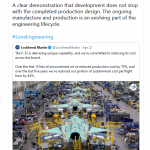Up or Down, Left or Right, Design Requirement or Nice to Have?

Your view point of the same problem can determine what is most important to you. This can vary with the present instance in time, the current development stage, your financial exposure, the current risks and so on. Different groups will also have different perspectives on the same project. These may be from the view of a stakeholder, a designer, a product manufacturer or safety analyst.
Up or Down
To illustrate this consider a car moving on a hill. There will be a perspective shift depending whether you are currently driving up or down. Whether at that point in time the importance is the engine or the brakes. The engine design department will have an interest in making the vehicle powerful enough to meet the performance requirements. However, the brake designers will be concerned in how heavy the engine will make the vehicle. The sales team will be interested in the power and acceleration, the safety manager in meeting the stopping distance standards. Everyone is looking at the same overall project. Each group has a slightly different view.
Ambiguity
Make sure your statements are unambiguous, don’t say left or right if there is no context of forward/backward. “The Data Entry swipe shall be placed to the Left of the door”, when you are facing the door or having walked through it? “The pipeline will turn Right at the harbour entrance….” without context of North and South this could be meaningless. If you were using directions stick to West and East, if you are describing a layout stick to a grid or co-ordinates with a defined origin.
Single Source
The importance of good design is capturing the information once and then providing routes or view points to this singular source of data. The ‘performance’ criteria should link to both the acceleration and torque requirements as well as the breaking expectations. We should be able to look at a system design element and trace to the user requirement that raised it. Equally we should be able to view the original requirement and trace through the design to the test that shows the project provides what was asked for. It is also important to consider how this data is displayed; graphically, hierarchically, textually, within a tool or within a document or presentation. By using a single data repository you can be sure that whatever form or view is required it is based on a homogeneous system rather than disparate parts.
Considering the different audiences your Cradle contents may have, think and discuss with 3SL the best way to present this. Some methods are highlighted in this video.
Training Course
The public training course for May covered Requirements Management. We’re lining up for June’s Document Publisher course on the 23rd-24th. Book now if you would like to reserve a place. These public courses are open to all, great if you only have a couple of people needing training, or wish to get feedback from other candidates using the product. If you want a course specific to your company or with tailored content please don’t hesitate to contact salesdetails@threesl.com
Social Media

We were impressed in the iterative lifecycle savings made over multiple productions of a product class, in Lockheed Martin‘s tweet.
We hope you had a good St. George’s Day. We remembered how simple ‘push-to-talk’ used a protocol to ensure everyone took their turn and illustrated it with a sequence diagram.
Finally
That’s all for our May 2021 Newsletter, but let us know if you got any more than the 17 disasters waiting to happen in our health and safety post by either replying to the Tweet, or emailing us at social-customer@threesl.com

